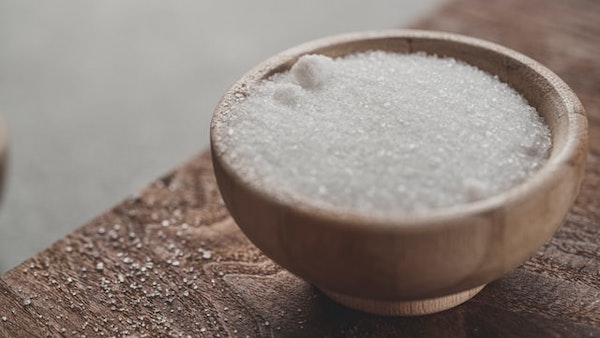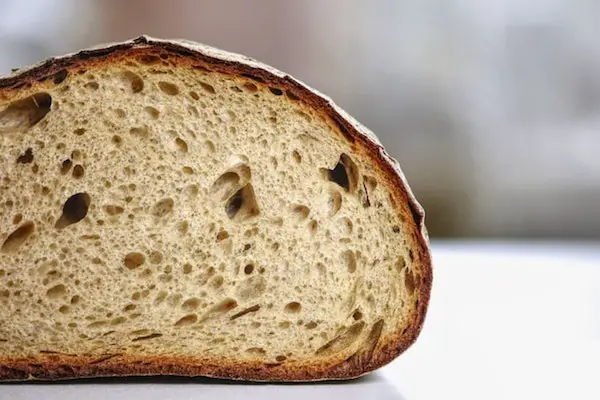Making bread will involve a variety of ingredients and tools, and understanding the specific roles and functions each does will ensure your bread comes out tasty with A+ quality texture.
Even the most common ingredients in your kitchen can drastically change how your bread turns out- even in tiny doses.
The 5 main ingredients in bread include the following:
- Sweeteners
- Salt
- Flour
- Yeast
- Oil
Luckily, you can find all these bread ingredients from many places, including the internet and through local grocery stores.
And in this post, we’ll share what each baking ingredient is, why it’s crucial for bread-making and what their respective ratios are for making a delicious loaf.
Flour
The first thing you think about when it comes to bread is flour, more specifically gluten flour. Vital wheat gluten or gluten flour is taken from high protein wheat. It also serves as a binder, helping your dough become more stretchy/elastic.

If the flour contains less than 16% protein, you’ll want to add more gluten so as to maintain that stretchy “binding” characteristic.
As a fun fact, gluten helps mitigate the damage done to bread gluten because of the jagged edges of the bran during the milling procedure. Gluten really holds it all together (literally!)
A good ratio to keep in mind with gluten flour is 1 to 2 tablespoons for every loaf
Be careful not to add too much gluten flour, since it will lead to bread becoming rubbery and tough.
Sweeteners
Liquid sweeteners, like honey, molasses or plain ol’ sugar, are a popular bread-making ingredient because it adds more flavor and moistness to your loaf.
plus, it helps extend the shelf life AND gives it a nicer aesthetic #instaworthy.
Not only that, sweeteners are amazing food for your hungry yeast that lives in your dough.
A good ratio to keep in mind is 1/3 cup of honey for every 2 loaves of bread.
As a word of caution, when using honey as your choice sweetener, be sure to adjust your oven temperature to a lower setting since very high temperatures can scorch and brown the bread.
Malt, barley malt syrup or diastatic malt powder are sweet derivatives of toasted barley. These provide nutrition and boost texture, shelf life and appearance.
Exchange 1 tablespoon of sweetener in the recipe together with 2 tablespoons of syrup and 1/2 teaspoon of powder. But be careful with the amounts here, since putting too much will make your bread gummy and very sweet or bitter and dense.
Salt
Like many things, salt is a much needed ingredient for bread.

Not only does salt boost the flavor of your bread, but it also helps manage the fermentation process AND gives your bread some height once baked.
Seriously, if you have ever tried eating bread without salt, it has no taste and is pretty flat – whoomp whoomp.
And if you’re wondering what kind of salt can you use for bread making, real salt, earth mineral salt or unrefined sea salt are perfect.
On that note, when making your dough, do not add salt to the liquid where the yeast is dissolving since this can prevent yeast growth.
In fact, a good ratio to think about is 1 tablespoon of salt for every 2 loaves of bread.
Yeast
Yeast is a microorganism that is a part of the fungus family. Although there are 1000s of yeast varieties in existence, the most relevant one for baking is Saccharomyces Cerevisiae. This is THE yeast that is perfect for bread dough.
Yeast requires food, warmth and moisture to grow properly. Temperature should be around 100 to 110 degrees F to get the best results.
Yeast can ferment sugars into alcohol and carbon dioxide. The resulting gas is then trapped inside the gluten network, helping the bread rise until all the oxygen is consumed or the yeast is killed from over-fermentation or baking.
The two common yeast types available are instant yeast and regular active dry yeast. The two have been dried to deactivation, although the yeast cells are not destroyed.
Instant yeast dried at lower temperatures can produce more live cells and are fast to act when water or flour is added. Compared to active dry yeast, instant yeast doesn’t have to be dissolved or proofed in warm water. This can be added together with the flour after the initial 2 cups of flour have been added.
Read More: Yeast 101: What Types of Yeast are Out There?
When it comes to bread-making, yeast has two roles: one is as a leavening agent. This means it helps the bread rise and creates a more open and airy texture.
The second role is to add strength and structure to the dough. This, in conjunction with gluten, adds much needed strength to the dough and holds all the air bubbles within its structure.
Adding Liquids
Water is the cheapest, fastest and easiest liquid to use. It helps create a chewier bread texture and enhances the flavor.
Milk helps make bread rise faster, creates a finer texture and has a longer shelf life.
Buttermilk helps make dough become tenderer and acquire a nicer taste.
Yogurt adds tang and can be substituted for 1/2 of liquid replacement.
Vegetable juices and broth like apple juice and tomato juice can be used to add nutrition and improve texture and taste.
Oil

Although not all recipes call for it, oil plays a role in certain types of bread.
The oil boosts the taste, texture, and moisture of bread. This happens because oil contains many fatty acids and lecithin which makes the dough easier to handle and prevent it from being sticky. Oil is also great for extending bread shelf life and tends to keep breads soft and fresh for a longer period of time.
The types of oil that can be used for bread making include the following:
- olive oil
- vegetable oil (i.e. canola, rapeseed, corn, soybean, etc.)
- flavored oils (walnut oil, garlic oil, etc.)
A good ratio is to add 2-5% of the total flour weight in oil to your dough.
Lecithin
Lecithin is a naturally occurring supplement containing a mixture of fats with a mixture of triglycerides, phospholipids and glycolipids and a small amount of carbohydrates. It comes in liquid, granular and powdered forms, and is a great alternative to eggs, honey, and oil.
Within its role in bread-making, lecithin helps keep bread soft and moist. It slows down the oxidation of the liquid components when making dough and functions as a binder/emulsifier.
Use 1.5 tablespoons of granular or liquid lecithin per loaf to act as a sufficient binder
Note: If you use the powdered form, make sure to follow the guidelines written on the can.
Oats
Putting sats or oatmeal in your bread gives it added moistness and crunchy texture. Plus, it makes for a kick-butt toasted bread experience.
A good ratio to keep in in mind is 1 cup of rolled oats for every 2 loaves.
To incorporate oats into your bread, pour 1 to 2 cups of boiling water over the rolled oats and allow to cool. Then add to your dough.
Explore all the Possibilities of Your Bread Ingredients
When it comes to making bread, adding various ingredients is a great way to experiment and see how it affects the taste and shape. As long as you keep the main ingredients intact, you’re on your way to a fun, boundless baking adventure.


